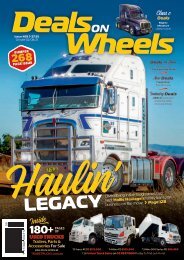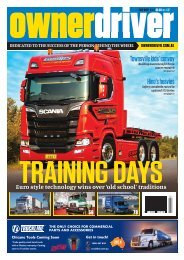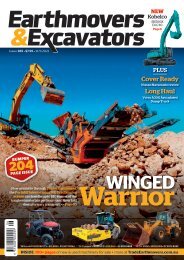Farms & Farm Machinery #401
Create successful ePaper yourself
Turn your PDF publications into a flip-book with our unique Google optimized e-Paper software.
News<br />
BALING<br />
Krone’s solo bale wrapper features a new ground<br />
roller, guide roller and bale turner to make the<br />
unit safer and more convenient<br />
Freestyle flow<br />
Krone has released its first ever solo bale wrapper to the<br />
Australian market and claims the machine has the world’s<br />
fastest single arm wrapping speed.<br />
Boasting a speed of 36 rpm, the EasyWrap 150 runs with<br />
fully automatic function from bale pick-up to discharge.<br />
Krone’s assistant product manager Nathan Thomas<br />
describes the new product as “versatile” and says it combines<br />
several stages of the process into one.<br />
“Be it collecting, wrapping or unloading bales, the new<br />
EasyWrap 150 is extremely versatile,” he says.<br />
“The fully automatic 3PL single arm wrapper can be<br />
mounted on the front or rear linkage as well as telescopic<br />
loaders to suit any operation.<br />
“With its powerful wrapping technology and ability to wrap<br />
up to a maximum bale weight of 1,600kg, farmers can rely on<br />
the EasyWrap 150 to balance efficiency and safety, while also<br />
maintaining maximum silage quality.”<br />
Thomas also says safety and convenience were “top of<br />
mind” for Krone when designing the EasyWrap 150.<br />
One feature added by Krone is a ground roller, which means<br />
the tractor does not have to lift the wrapper’s entire weight.<br />
“The ground roller makes it much easier for farmers to<br />
transport hay bales on slopes and hills – it also means<br />
farmers can wrap heavy bales with smaller tractors,”<br />
says Thomas.<br />
Krone says that the EasyWrap 150 has the world’s<br />
fastest single arm wrapping speed<br />
There is also a bale turner to safely place a bale on its end,<br />
a guide roller to improve guidance during wrapping and a<br />
film roll holder with external keypad to operate from outside<br />
the cabin.<br />
Mounting brackets hold up to four extra film rolls, while<br />
large bobbins improve bale control and ensure smooth<br />
rolling, particularly in sloping fields.<br />
John Deere’s collaboration with<br />
the University of Sydney will test<br />
its ExactEmerge row units on a<br />
100-hectare cotton field<br />
“That is important because your rate of loss accelerates<br />
greatly after the optimum window has passed, but with<br />
a high-speed planter, you can avoid missing that optimal<br />
planting window. This makes an enormous contribution to a<br />
farmer’s chance of achieving the highest crop yield possible.”<br />
The technology has been demonstrated at the University of<br />
Sydney’s Llara property, outside Narrabri in northwest NSW,<br />
where the 1850-hectare farm is used to produce dryland<br />
PLANTING<br />
New technology currently being trialled<br />
could see the speed of seeding double<br />
Need for speed<br />
John Deere is testing its ExactEmerge row units, which it<br />
hopes will increase planting speeds to 16km/h – double the<br />
typical speeds of standard planting.<br />
The manufacturer is testing the speeds as part of a<br />
collaboration with the University of Sydney, which will also<br />
include third-party validation.<br />
Once fully tested, John Deere hopes ExactEmerge<br />
will provide farmers with a quicker alternative while still<br />
maintaining accurate singulation, seed population, spacing,<br />
applied downforce and uniform depth.<br />
Able to integrate with both new and older planters, the<br />
ExactEmerge technology can be used on crops such as<br />
cotton, sorghum, sunflower and summer grains.<br />
John Deere Australia precision agriculture manager Benji<br />
Blevin says the collaboration with the university’s Institute of<br />
Agriculture will highlight the technology’s performance and<br />
its suitability for Australian conditions.<br />
“Growers are typically used to planting at 8km/h but what<br />
we want to show is, using ExactEmerge, they can achieve the<br />
same accuracy at double the speed,” says Blevin.<br />
“That ability to cover twice as many hectares as a traditional<br />
planter in the same amount of time has the potential to<br />
significantly shift the goal posts during the planting season.<br />
“When you can plant at 16km/h with the confidence that<br />
you’re not compromising seed placement, you are effectively<br />
increasing the optimum planting window.<br />
L-R: John Deere product specialist Anton Kowalenko,<br />
John Deere precision agriculture manager Benji Blevin<br />
and University of Sydney director of northern agriculture<br />
associate professor Guy Roth<br />
wheat, canola, chickpeas, faba beans and dryland cotton<br />
alongside cattle.<br />
Results of that demonstration, which tested the<br />
ExactEmerge system on cotton grown in a large-scale<br />
100-hecatre area, are still being finalised, but University of<br />
Sydney director for northern agriculture Guy Roth says the<br />
expected results look promising.<br />
“Growing crops is a combination of having good<br />
engineering, good agronomy and getting the timing right,”<br />
says Roth.<br />
“In this validation, John Deere provided the technology<br />
and we brought academic rigour to the agronomy and soil<br />
science, so it was the perfect opportunity to collaborate and<br />
conduct this large-scale validation study.<br />
“Using ExactEmerge, we were able to get a very good, even<br />
plant stand across all the treatments and soil types which is<br />
very important when planting cotton.”<br />
6 <strong><strong>Farm</strong>s</strong> & <strong>Farm</strong> <strong>Machinery</strong>
















